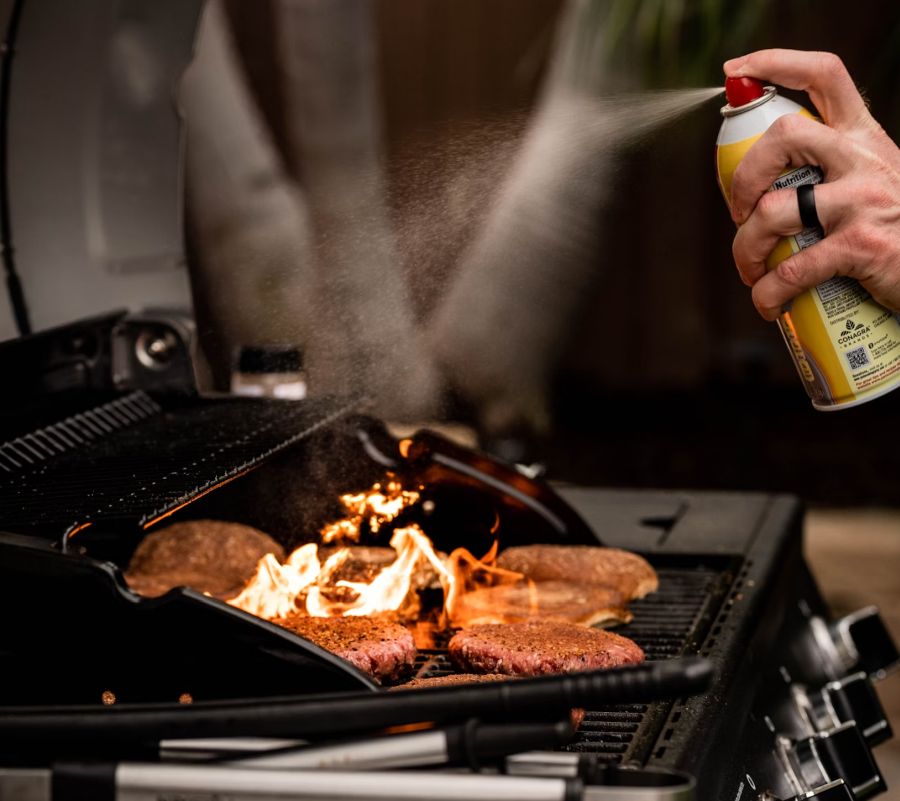Cooking spray is an amazing option that makes cooking more convenient and quicker. There is every reason to prefer and enjoy its use. However, should you need them, there are plenty of cooking spray substitutes that can do the job just as well, if not better.
In fact, it serves well to remember that cooking spray itself was designed as a substitute for conventional cooking methods. It is more convenient and generally uses less oil, making it popular with the health-conscious. However, similar convenient options and substitutes do exist and are easily available.
There’s a good chance you have a good cooking spray substitute in your pantry or kitchen right now. These can be your conventional options like butter, oil, lard, or even ghee.
Let’s get into the details of these options.
Table of Contents
Top Cooking Spray Substitutes To Use
1. Lard (Or Other Animal Fat or Grease)
Lard has been a favorite for cooking for a very long time. It’s lost its popularity somewhat since the arrival of more convenient cooking options, but it’s still a useful way to grease food, pots, or pans for cooking. It’s soft and will easily spread on a surface with just your fingers, parchment paper, or spatula.
Plus, it can handle high temperatures while cooking, so it works rather well for cooking or roasting vegetables and meat.
The downside here is that lard has a distinct and somewhat stronger flavor than most cooking oils, including those used in cooking spray. One way to minimize this effect would be to use a very thin coating of lard, but that may not always be possible.
If you don’t have lard at hand, other similar options can be used, including bacon grease. However, this too is strongly flavored.
2. Unsalted Butter

Butter is one of the best options available to substitute cooking spray. Before cooking spray was a thing, most people relied on butter to perform the task of greasing pans and pots.
The method is simple. Melt the butter and apply it to the pan or pot you intend to grease. Butter is easy to work with and can be spread using fingers, silicone brushes, spatulas, or other similar cooking tools.
If you want to get the use of butter truly close to that of cooking spray, be sure to apply as thin a lining as possible, so that the butter doesn’t significantly alter the flavor of your recipe.
For all its great qualities, butter has some limitations with temperature. So, while it can work for baking or low temperature cooking, it doesn’t quite work all that well with cooking at higher temperatures or for roasting meat and vegetables.
This is why other options like cooking oil, shortening, or lard might be preferable for such uses.
3. Regular Cooking Oil
In essence, cooking spray is just regular cooking oil in a watered-down and pressurized setting. So, if you want a substitute that hits close, use conventional cooking oil to do the job.
With this option, you can use whatever your choice of oil is. These include safflower oil, canola oil, avocado oil, or several other types of cooking oil.
Your choice can depend on the flavors you are working with. For example, canola oil or safflower oil offer neutral flavors that won’t affect your recipe much. However, other options like groundnut oil or sunflower oil can affect the flavor of the recipe.
You can use olive oil too, though it can affect the flavor of the recipe. Additionally, olive oil isn’t really suitable for high temperature cooking or roasting.
4. Vegetable Shortening (Vegetable Oils)
Another good option to try as a cooking spray alternative is vegetable shortening. Once fairly popular, it has seen a decline in usage in recent years, but continues to be readily available and used. Brands like Crisco are fairly common and also offer their own cooking sprays along with vegetable shortening.
Shortening is usually solid at room temperature but melts easily. You can apply it to the pan or utensil of your choice using your fingers or utensils like a spatula. It melts rather quickly once heated and works as a regular oil. Vegetable shortening can be used at higher temperatures, so its use in general cooking and roasting is entirely possible.
5. Ghee
Ghee is a milk-derived fat that’s very popular in Indian cooking and cuisines, though it’s been making its way to other cuisines and cooking as well. It’s usually semi-solid at room temperature, but melts quickly under heat. So, you can apply it to the pan using your fingers or using utensils like a spatula.
However, ghee has a distinct, nutty flavor that can affect the overall flavor of your recipe. It’s usually a welcome touch in Indian cuisine, but may not be that desired in other cuisines, though it’s worth a try if you haven’t used this ingredient before! If you’ve had a famous Indian dish like Butter Chicken, it’s very likely that the chicken was roasted in ghee, which can handle higher temperatures, unlike butter.
6. Use A Refillable Spray Bottle (DIY Option)
As we know, cooking spray is basically cooking oil and some water in a pressurized container. An easier option would be to use simple spray bottles, without the pressurization. This way, you can easily spray the cooking oil as needed and refill the bottle once it goes empty.
The problem here is longevity. Without the pressure and preservatives of conventional cooking spray, the oil and water mixture in a refillable bottle isn’t very stable. The oil and water mix can separate rather quickly, and the mix will go rancid if not used within a couple of days.
So, if you do choose a refillable spray bottle, go with a tiny option that can be completely used in a day or two.
Although, if you choose to keep this refillable bottle limited to oil only, it can last longer. However, I’d still recommend using a smaller bottle for its convenience of use.
Some Additional Points On Using Cooking Spray Or Its Substitutes And FAQs
Cooking Spray And Baking Spray Are Similar, But Not The Same
The cooking spray and the cooking spray alternatives listed here are best for cooking and roasting food. They may not work as well if you intend to substitute baking spray.
The reason for this, and a subtle difference in cooking spray vs baking spray is the presence (or use of) flour. Baking spray includes a small amount of flour that gets released with each spray and forms a coating. This keeps your baking pans truly non-stick when used for baking.
Therefore, if you intend a baking spray substitute, simply add a dusting of flour to the utensil along with the aforementioned cooking spray substitutes. When baking, it’s best to use the same flour for lining the tin/utensil, as the one used for the recipe of the baked goods.
It’s that simple!
Is There A Paleo-friendly Alternative To Cooking Spray?
You can use cold-pressed coconut oil or extra-virgin olive oil if you’re looking for paleo-friendly alternatives to cooking spray oil. Both of these options are nourishing and quite useful. Coconut oil can easily withstand higher cooking temperatures and is suitable for most recipes. However, it does come with a touch of its flavor.
Extra-virgin olive oil may also be able to withstand high temperature cooking or roasting, though this option too might bring a flavor of its own.
However, there are some pale-friendly variants depending on the manufacturing company, which may offer more subtle and suitable flavors for coconut oil and olive oil.
Is Cooking Spray A Substitute For Cupcake Liners?
You can use cooking spray to substitute cupcake liners. However, just the spray itself may not be sufficient. After the spray, give the vessel or tin a thin dusting of flour to make it truly suitable for use with cupcakes. It’s better that the dusting flour is the same as the one used for your cupcake recipe.
Better yet, if you have baking spray, use that in place of cooking spray. This will also remove the need of dusting the pan/tin with flour.
What Is A Substitute For Cooking Spray In Crock Pot?
You can use the conventional substitutes for cooking spray in a crock pot. Line the pot with soft butter, lard, conventional cooking oil, or vegetable shortening. Any of these can be a suitable choice for your crock pot recipe.
What Is A Suitable Substitute For Cooking Spray In An Air Fryer?
It is generally believed that cooking spray is not the best choice for your air fryer. A better option would be to use simpler oil sprays that aren’t pressurized and don’t utilize aerosols. You can also consider lining the fryer basket with alternatives like butter and cooking oil.
Conclusion – Cooking Spray Substitutes To Use
As we see, cooking spray substitutes are an easy find, especially, since cooking spray itself was designed as a more convenient way to use conventional oils or fat in cooking. So, while the convenience of cooking spray is tough to beat, you can use conventional oils and fats like butter, cooking oils, or lard for your cooking needs.

